Allergies are currently one of the most common conditions affecting not only adults but also children and infants. Asthma, rhinitis, eczema, and food allergies are a common problem that parents and pediatricians encounter. According to statistics, one in ten children suffer from asthma, and the percentage of children with allergies increases with age. While it is about a quarter among five-year-olds, over 35% of seventeen-year-olds have allergies. In small children, food allergy is most commonly associated with atopic dermatitis, in up to 80% of cases. How do allergies develop in children, what are their symptoms, and what are the ways to treat them? You will find all this in the following article.
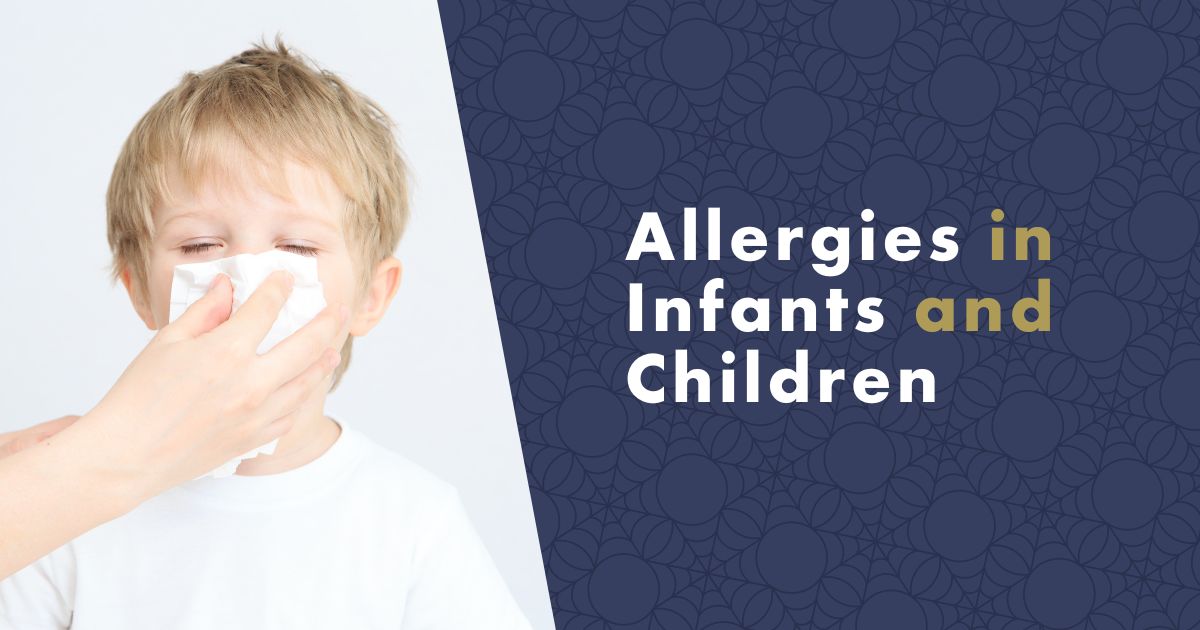
What Is an Allergy?
An allergy is an immune system response to substances that are harmless to most people. These substances, called allergens, can come from various sources - such as pollen, mold, dust mites, cat dander, foods, and many others. During an allergic reaction, various chemical substances such as histamine are released, causing symptoms such as itching, redness, swelling, runny nose, coughing, and more.
Most Common Allergies in Children and Infants:
- Food allergies: most commonly to milk, eggs, peanuts, tree nuts, fish, shellfish, soy, wheat and other grains.
- Dust mite allergies: they are the main allergen causing asthma and allergic respiratory diseases in children.
- Insect venom allergies: insect allergens can be very strong and cause allergic reactions that can be life-threatening.
- Pollen allergies: spring and summer pollen from grasses, trees and flowering plants can cause seasonal allergic rhinitis, asthma or conjunctivitis.
- Pet hair allergies: the main allergens are cats and dogs, but allergies can also affect other domestic and wild animals.
- Drug allergies: some children may be allergic to certain medications, such as antibiotics, aspirin, or nonsteroidal anti-inflammatory drugs.
- Metal allergies: some metals, such as nickel, can cause allergic skin reactions.
- Chemical allergies: some chemicals, such as dyes, preservatives or perfumes, can cause allergic reactions in sensitive individuals.
Symptoms of Allergies in Children and Infants
Here are some symptoms that parents should watch for in their children if they suspect an allergy:
- Rashes and eczema on the skin.
- Diarrhea and blood in the stool.
- Weight loss.
- Vomiting after eating.
- Swelling.
- Persistent runny nose and cough.
- Frequent illness.
- Wheezing in the chest.
- Nighttime or exercise-induced cough and shortness of breath.
- Stuffy nose and sneezing.
- Frequent conjunctivitis.
- Larger swelling or excessive itching after insect bites or taking medication.
f any of these symptoms occur, they may be a sign of an allergy, and it is important to seek professional help. An allergist can assist with the diagnosis and treatment of allergies in children.
Effective Ways to Manage Allergies in Children and Infants:
- Identify specific allergens: If it is a food allergy, it is important to determine what your child is reacting to and then avoid it. If it is an allergy to dust or pollen, you can try reducing the time spent outdoors or minimizing contact with the allergen. Using air purifiers for allergy sufferers and equipping beds with anti-dust mite covers, anti allergy pillows, and mattress protectors is also helpful.
- Consult with an allergist or pediatrician: If your child has an allergy, it is important to consult with a pediatrician who can prescribe antihistamines or other medications to treat symptoms. Nasal irrigation is particularly effective for allergic rhinitis.
- Regular cleaning: Cleaning can reduce the level of allergens, such as dust mites, mold, or pet hair. Ozone generators are very effective at killing dust mites in mattresses and upholstery and can also combat mold.
- Minimize contact with animals: If your child is allergic to animals, you should try to minimize contact with household pets. At a minimum, they should not be allowed into the bedroom or children's playroom.
- Use non-toxic cleaning products: Today, there are a variety of natural or non-toxic cleaning products on the market that do not contain chemicals, which can irritate your child's sensitive skin.
The Impact of Group Settings on Childhood Allergies
Starting school or kindergarten can promote the development of new allergies or change the forms of existing allergic symptoms in children. This can be caused by several factors, including an increase in contact with various allergens in the collective environment, such as different bacteria, viruses, molds, mites, as well as changes in nutrition, sleep, and other factors that affect the immune system
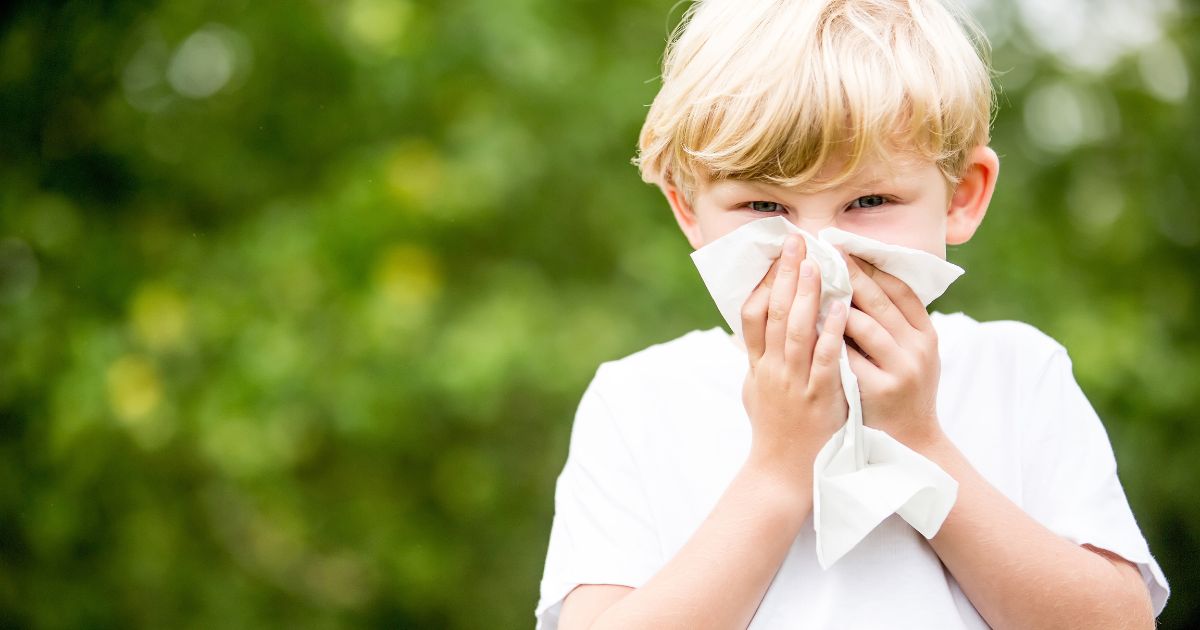
Children with Allergies Are More Prone to Respiratory Illnesses
During this time, the most significant factor is usually the child's entry into a collective setting, where the child is exposed to and infected by various allergens more frequently. This increased susceptibility to illness is particularly common among allergy sufferers, who often have a weaker immune system, and can lead to complications such as bronchitis with wheezing and coughing, prolonged runny nose, or middle ear infections.
Allergies in Children Can Change over Time
In children with a hereditary predisposition to allergies, allergy symptoms can change and be diverse over time. During early childhood, skin manifestations such as atopic eczema and food allergies are more common. During preschool and school age, these symptoms may disappear and sensitization to airborne allergens such as mites, pollen, mold, and animal allergens may occur. Symptoms of bronchial asthma, allergic rhinitis, and conjunctivitis may also appear.
The entire life cycle of allergies is called the allergic march, in which allergies can combine, disappear, and reappear. Therefore, it is important for parents not to neglect the symptoms of allergies in their children and to respond promptly to any new allergy symptoms so that they can seek professional help and treatment in a timely manner.
Can Allergies in Children Be Prevented?
The predisposition to allergies is hereditary and lifelong, so it is not possible to completely prevent the development of allergies in children. However, there are measures that can help minimize the risk of developing allergies. During pregnancy, it is important to avoid smoking, follow a healthy diet, and minimize exposure to chemicals and pollutants. Breastfeeding also helps prevent allergies, as does a healthy lifestyle for the child that includes a healthy diet, regular exercise, cold water immersion, and a varied diet.
Can Allergies in Children Disappear?
In some cases, it may be a transient manifestation, for example, in the case of allergy to certain foods, it may disappear.
Are Allergies Dangerous for Children?
It depends on the severity of the allergy. In many children, allergies are a chronic condition that can be potentially life-threatening in severe cases and requires treatment. In such cases, it is important to seek professional help from an allergist who can help identify the allergen and prescribe appropriate treatment. If the allergy is diagnosed in a child at an early age, it can help minimize the risk of developing more severe forms of allergic diseases in the future.
Can Untreated Allergies Harm the Health of Children and Infants?
Untreated allergies in children and infants can have serious consequences on their health. Allergic diseases often have a chronic course and can damage some organs in the body. If the allergy remains untreated, it can lead to permanent, irreversible changes in the affected organs, such as thinning of the skin and worsening of its defense mechanisms, or permanent narrowing of the airways, which results in reduced oxygenation of the body and slower growth.
Furthermore, untreated allergies can lead to an increase in sensitization to other allergens, which can worsen the child's condition. Therefore, it is important to seek professional help and start allergy treatment for the child in a timely manner. An allergist can assist with diagnosis and prescribe appropriate treatment, including allergen immunotherapy, which can prevent an increase in sensitization to other allergens.
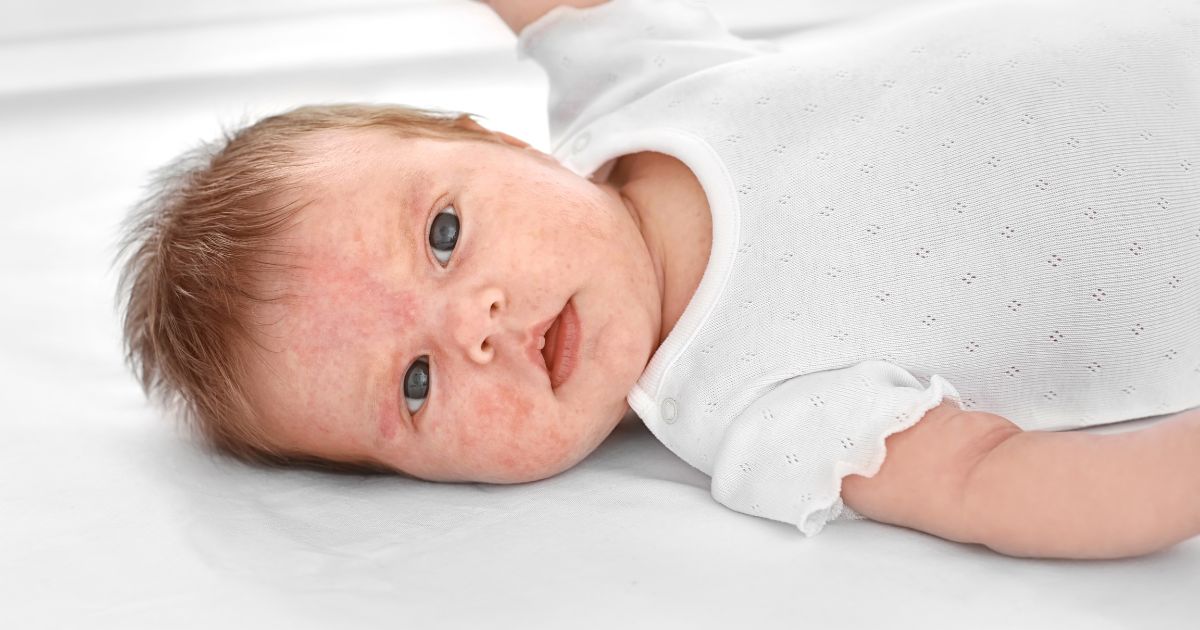
How Is Allergy Testing Performed in Children and Infants?
First, a medical history and analysis of the environment in which the child lives, their diet, and sports activities are conducted. Then, skin allergy tests, blood tests examining levels of specific IgE antibodies, cellular and antibody immunity parameters, spirometry to assess the condition of the airways, and functional pulmonary tests can be performed. The level of exhaled nitric oxide (NO) can also be measured in the condensate of exhaled air, which indicates the level of inflammation in the airways. Diagnostic and treatment methods are constantly improving. Laboratory methods are becoming more precise and allow for diagnosis of an increasing number of allergens, including recombinant allergens.
What Are the Symptoms of Food Allergy in Infants?
Food allergies in infants are common and can manifest in various ways, including skin symptoms (rashes, itching, swelling), digestive problems (diarrhea, vomiting, bloating), breathing difficulties (shortness of breath, wheezing), and other symptoms. The most common allergens in infants are:
- milk,
- eggs,
- soy,
- wheat,
- nuts,
- fish, and shellfish.
If parents observe any of these symptoms in their child, it is important to seek medical help and undergo diagnostic tests. If a food allergy is confirmed, it will be necessary to avoid the allergen in the food and possibly undergo allergen immunotherapy.
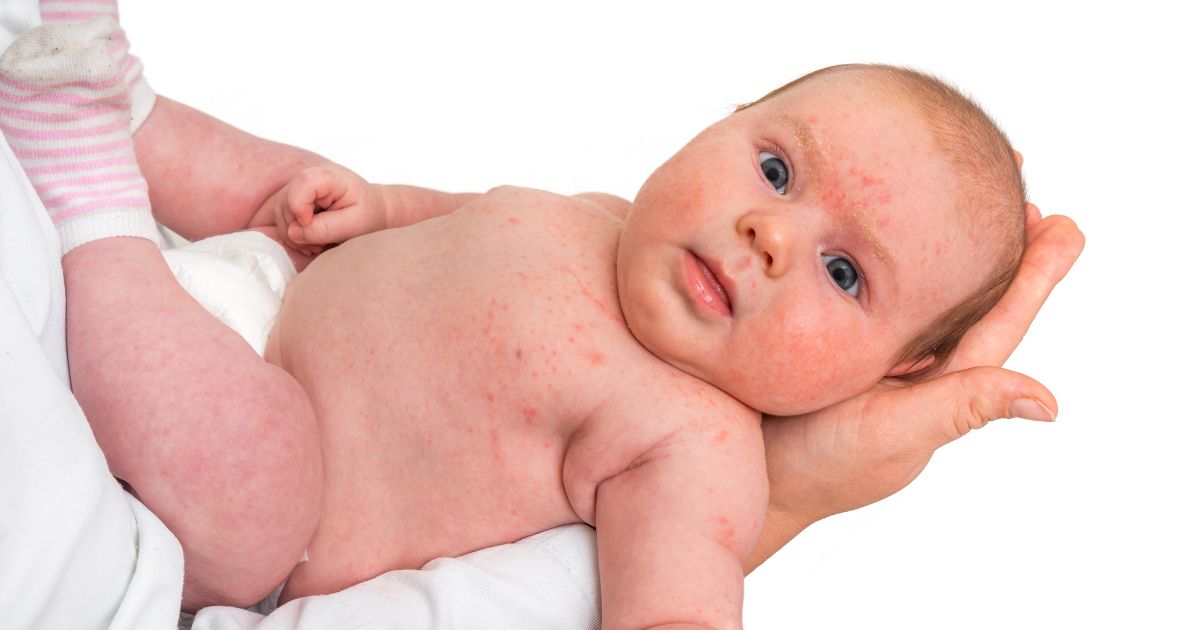
How to Deal with Pollen Allergies in Infants and Young Children?
Allergies to pollen in infants and children can manifest as a runny nose, coughing, teary eyes, rashes, and even diarrhea and vomiting. If these symptoms appear during times of high pollen concentration, it may indicate an allergic reaction to pollen. In such cases, it is important to seek medical help from a pediatrician or allergist as soon as possible, who will determine the appropriate treatment.
In addition to treatment, parents can take preventive measures for their infants, such as limiting outdoor time during times of high pollen concentration, using a high-quality air purifier throughout the home, regular vacuuming, and using air conditioning with filters. Breastfeeding can also help strengthen the child's immunity in cases of pollen allergies.
What Helps with Dust Mite Allergies in Infants and Young Children?
Allergies to dust mites in infants and children are among the most common allergies that can lead to asthma. It manifests as a runny nose, coughing, teary eyes, rashes, as well as sleeplessness and irritability. If your child's allergy symptoms occur primarily at night, it is very likely to be an allergy to dust mites. Check out an article on what is dust mite allergy, where you can learn how to fight it.
The most important prevention measure is to use dust mite-proof bedding, mattress and pillow covers, which keep dust mites away. Similarly to pollen and animal allergies, regular cleaning and the use of high-quality air purifiers for allergy sufferers throughout the home are important.
#produkty#https://www.nanospace.store/anti-dust-mite-covers/
How Does Gluten Allergy Manifest and How Is It Treated in Children and Infants?
Gluten allergy, also known as celiac disease, is an autoimmune disorder that causes malabsorption of nutrients in the small intestine. This condition can affect both children and adults and often manifests as digestive problems such as diarrhea, vomiting, constipation, or bloating. In children, gluten allergy can have a negative impact on growth and development and can lead to further complications if not properly diagnosed and treated.
The diagnosis of gluten allergy is based on blood tests or biopsy of the small intestine. If your child is over 2 years old, you can also perform a home test for gluten allergy.
If gluten allergy is confirmed, it is necessary to completely eliminate foods containing gluten, such as wheat, rye, barley, oats, and other derived foods, from the diet. There are now many replacements for gluten-containing foods available on the market, such as rice, corn, quinoa, chickpea, and other types of flour and cereals. It is important to ensure that the child's diet contains all the necessary nutrients and vitamins that are commonly found in gluten-containing foods. Therefore, parents can consult with experts on how to feed their child healthily and balancedly, who suffers from gluten allergy.
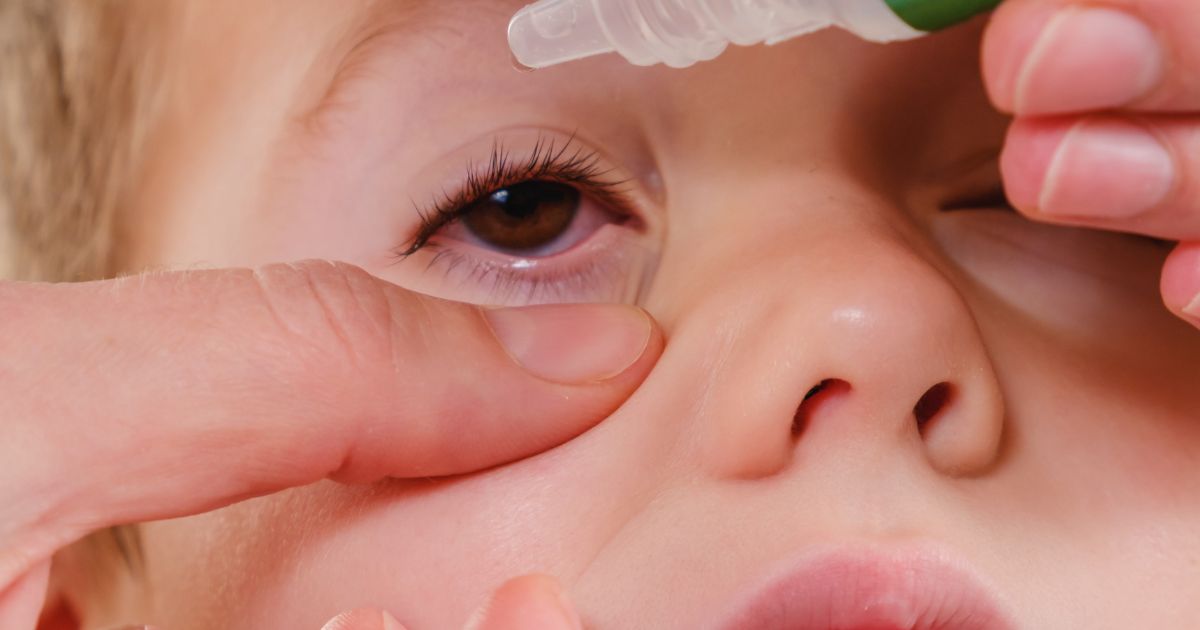
How to Strengthen Children's Immune System?
To strengthen children's immune system in the autumn, it is recommended to encourage natural physical activity in fresh air, provide a varied diet rich in vitamin C, and not underestimate the recovery time after infectious diseases, including common colds. It is important to avoid exercise, training, and more demanding physical activities for at least a week. Additionally, some dietary supplements, such as vitamin D3 and the popular colostrum, can be used to support the immune system.
FAQ
How to recognize allergies in babies (infants and toddlers)
Allergies in babies can manifest in different ways and can be difficult to recognize. Typical symptoms include skin manifestations such as rashes, itching, redness and scaling. In addition, babies may have symptoms of digestive problems such as diarrhea, vomiting, bloating and abdominal cramps. They may also have breathing difficulties such as a runny nose, cough and shortness of breath. In some cases, neurological symptoms such as irritability, restlessness, insomnia and loss of appetite may also appear.
What do allergic reactions look like in babies (infants)?
Food allergies in infants can manifest in different ways depending on the allergen and the degree of allergic reaction. Some of the symptoms of an allergic reaction in babies may include:
- Skin manifestations: Rash, red spots, itching, swelling, redness and dry skin can be caused by food allergies or allergies to cosmetics or detergents.
- Difficulties breathing: Wheezing, coughing and shortness of breath can be caused by allergies to dust, mites, animal dander, pollen or mould.
- Digestive problems: Vomiting, diarrhea, abdominal pain and cramps can be caused by food allergies.
- Ocular manifestations: Runny nose, itching, watery eyes and conjunctivitis can be caused by allergies to pollen, mold or animal dander.
It is important for parents to be aware of these symptoms and seek medical advice if they suspect an allergy in their baby.
How to recognize milk allergy in babies and children?
Milk allergy is quite common in children, especially in infants. The most common allergy is to cow's milk proteins, but allergic reactions to sheep's, goat's or soy milk proteins can also occur. Symptoms of milk allergy in children include skin rashes, itching, swelling of the tongue, lips or face, diarrhoea, vomiting, bloating, wheezing, sneezing, runny nose or abdominal pain. These symptoms can appear immediately after exposure to the allergen or up to several hours after consuming milk. If you suspect that your child is suffering from a milk allergy, you should seek professional help from a doctor who can perform diagnostic tests and suggest appropriate treatment.
Sun allergy in children
Sun allergy, also called photodermatitis, can also affect children. It typically manifests as skin redness, itching, burning, and blistering after sun exposure. In children, the manifestations of sun allergy may be stronger and more pronounced than in adults. To prevent this allergy in children, it is recommended to protect the child from direct sunlight, use high-quality protective organic sunscreens, cover the skin with clothing and use a hat with a peak. If symptoms of sun allergy appear, it is advisable to contact a doctor immediately and undergo treatment, which may include the use of corticoids and antihistamines.
Cat allergy in babies:
Allergy to cats is one of the most common allergies in children and babies. It is caused by the protein Fel d 1, which cats excrete in saliva, pus and urine. Symptoms of cat allergy include sneezing, stuffy nose, itchy eyes and nose, runny nose, skin rashes and shortness of breath. If the baby shows any of these symptoms, it is advisable to seek professional help. One of the ways to prevent cat allergies is to reduce exposure to cat allergens by regularly vacuuming, washing floors and frequently cleaning cat objects
How does a dog allergy manifest itself in a baby?
Allergy to dogs in babies can have different manifestations. Typical symptoms are itching, frequent sneezing, runny nose, cough, shortness of breath, red and watery eyes, skin rashes or eczema. If these symptoms appear after contact with a dog, it is important to see an allergist so that the allergy can be confirmed and treatment can be started. There is immunotherapy for dog allergy, but it is also important to minimize exposure to the dog and create a dander- and dust-free environment for the baby. Therefore, do not let the dog into the children's room and bedroom and use a quality robotic vacuum cleaner and an air purifier.
Nut allergy in an infant:
Allergies to nuts are among the most serious food allergies. Babies are most often allergic to hazelnuts, almonds or walnuts. Symptoms of a nut allergy can be very serious and include swelling, vomiting, diarrhea, loss of consciousness, and difficulty breathing. If a child is suspected of having a nut allergy, they should be examined by an allergist and nuts should be excluded from the diet. The prevention of nut allergy in infants is adherence to infant formula and avoidance of nuts in the first years of a child's life.
What is hay fever in children divided into?
Hay fever or allergic rhinitis is an allergic disease that is manifested by runny nose, itchy eyes, sneezing and stuffy nose. Hay fever in children is caused by an allergy to plant pollen. Hay fever can be seasonal or year-round. Seasonal hay fever usually occurs when specific plants are in full bloom, while perennial hay fever can be caused by year-round allergens such as dust mites.
Learn More About Allergies:
- How to Recognize Allergies
- Dust Mite Allergies
- Feather Allergies
- Dust Allergies
- Allergy to Cats
- Allergy to Dogs
- Spring Pollen Allergies
- Combined or Cross-Reactive Allergies
- How to Prepare for Allergy Season
Sources:
- Gupta, R. S., Springston, E. E., Warrier, M. R., Smith, B., Kumar, R., Pongracic, J., & Holl, J. L. (2011). The prevalence, severity, and distribution of childhood food allergy in the United States. Pediatrics, 128(1), e9-e17.
- Bahna, S. L. (Ed.). (2018). Pediatric Allergy: Principles and Practice E-Book. Elsevier Health Sciences.
- Fiocchi, A., & Dahdah, L. (Eds.). (2016). Cow's Milk Protein Allergy: An Emerging Issue. Karger Medical and Scientific Publishers.
- Sicherer, S. H., Munoz-Furlong, A., Godbold, J. H., & Sampson, H. A. (2010). US prevalence of self-reported peanut, tree nut, and sesame allergy: 11-year follow-up. Journal of Allergy and Clinical Immunology, 125(6), 1322-1326.
- Sicherer, S. H. (2014). Food allergy: practical diagnosis and management. Springer.
- Wang, J., Visness, C. M., Sampson, H. A., & Food Allergy Study Group. (2005). Food allergen sensitization in inner-city children with asthma. Journal of Allergy and Clinical Immunology, 115(5), 1076-1080.
- Sicherer, S. H., & Sampson, H. A. (Eds.). (2019). Food allergy: Adverse reactions to foods and food additives. John Wiley & Sons.
- Savage, J. H., Matsui, E. C., & Wood, R. A. (2010). The prevalence of peanut allergy: a meta-analysis. Journal of Allergy and Clinical Immunology, 125(6), 1303-1309.
- Burks, A. W., Tang, M., Sicherer, S., Muraro, A., Eigenmann, P. A., Ebisawa, M., ... & Sampson, H. A. (2012). ICON: food allergy. Journal of Allergy and Clinical Immunology, 129(4), 906-920.
- O'Neil, C. E., & Smith, C. E. (Eds.). (2014). Allergenic Foods and their Immunological and Allergenic Properties. ACS Publications.
- Almqvist, C., Worm, M., Leynaert, B., Working Group of GA2LEN WP 2.5 Indoor Environment. Impact of indoor environments on children's respiratory health: GA2LEN harmonization report. Allergy, 2008, 63(10), 1344-1351.
- Schatz, M., Rosenwasser, L. J., & Zeiger, R. S. (2014). The diagnosis and management of sinusitis: a practice parameter update. Journal of Allergy and Clinical Immunology, 134(6), 1425-1433.
- Haahtela, T., Holgate, S., Pawankar, R., Akdis, C. A., Benjaponpitak, S., Caraballo, L., ... & Jutel, M. (2015). The biodiversity hypothesis and allergic disease: world allergy organization position statement. World Allergy Organization Journal, 8(1), 1-10.
- World Allergy Organization (WAO). (2011). White Book on Allergy: Update 2011. The Global Alliance against Allergy and Asthma (GA2LEN).
